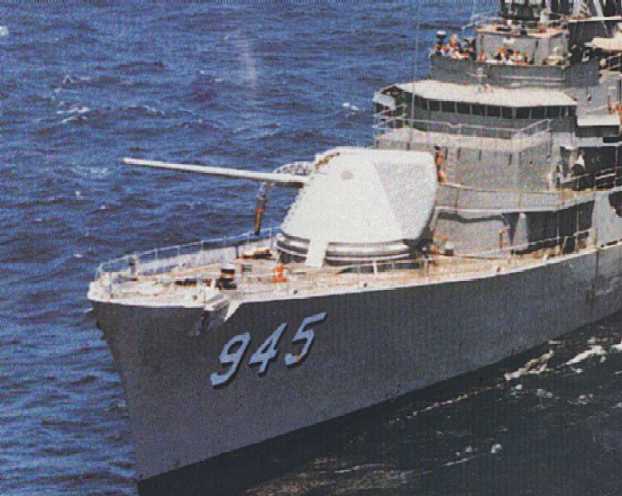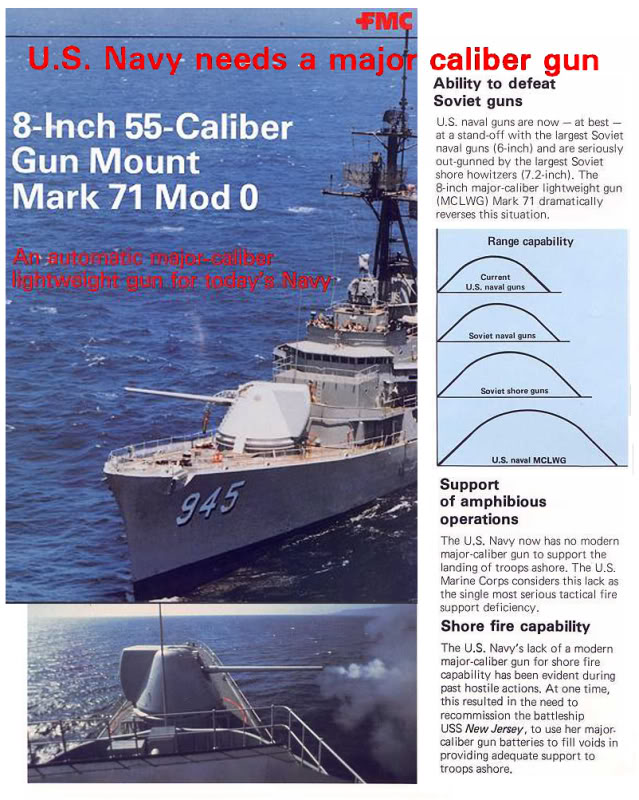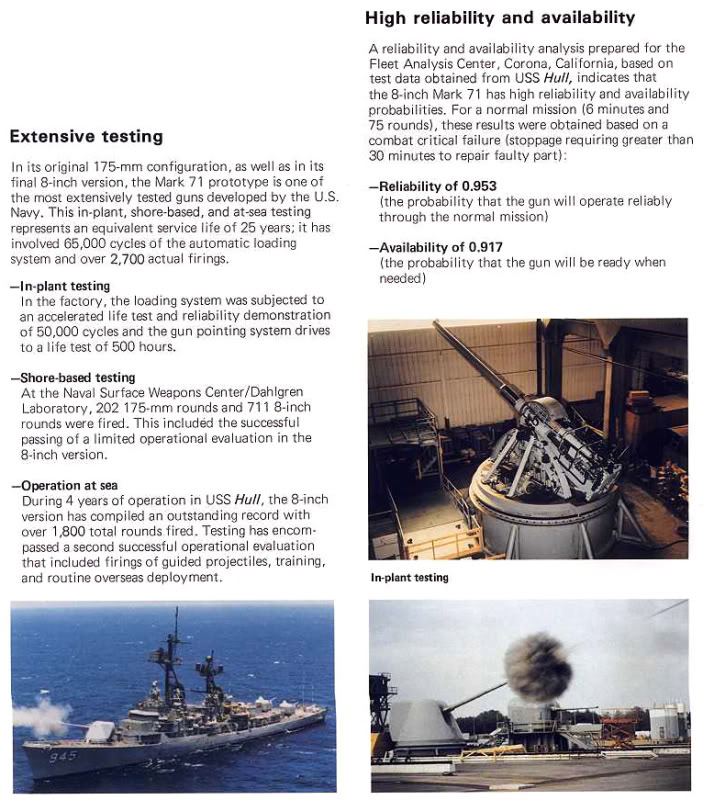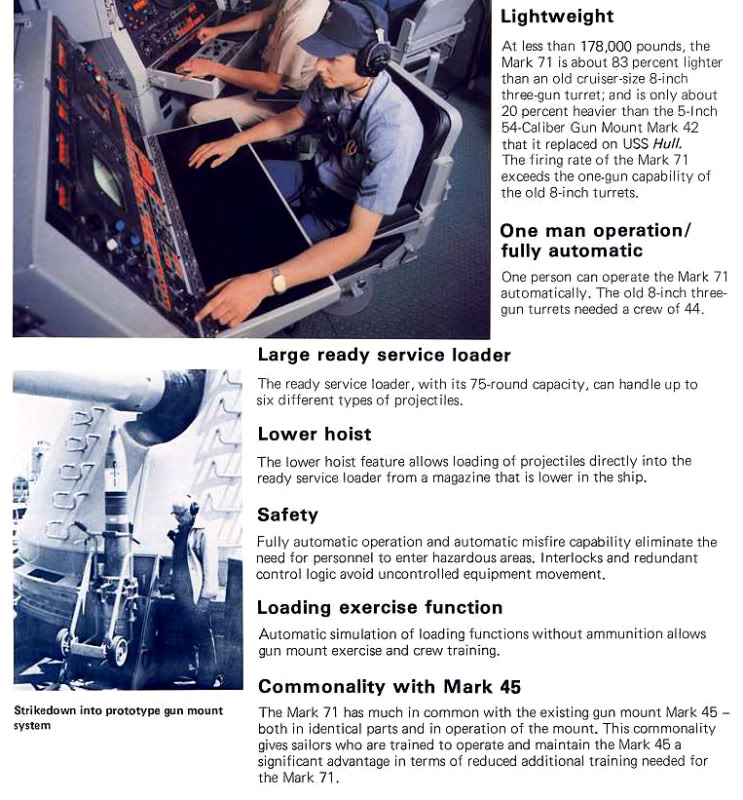After the retirement of the last of the World War II Baltimore and Cleveland class cruisers in the 1970s, the only ship-based shore-bombardment weapon remaining in the USN was the 5"/54 (12.7 cm) gun. This weapon was out-ranged by existing Soviet coast defense guns and its projectiles were incapable of destroying hardened bunkers. With the Navy's concentration on carrier task forces, it was also apparent that there would not be any future surface-warfare ships large enough to carry multiple heavy weapons. These developments were quite worrisome to those planners charged with ensuring the success of amphibious assaults.
The Major Caliber Light Weight Gun (MCLWG) program was an ambitious attempt at solving these problems. The goal of this program was to produce a larger-caliber gun capable of supporting amphibious landings yet still light enough to fit even on destroyer-size ships. The weapon was originally intended to be an adaptation of the Army's 175 mm (6.9") artillery gun, but the 8" (20.3 cm) caliber was selected during the initial evaluation testing in the early 1970's. The projectiles planned for the new weapon were to combine a large explosive charge together with long range and high accuracy through laser guidance and thus were to be able to attack even small targets such as individual bunkers. To make this weapon widely available throughout the fleet, plans were made to mount it on many of the proposed DX, DXG and CSGN designs of the 1970s, but the only ships actually designed and built to use it were the Spruance (DD-963) class destroyers (see Mount / Turret Notes below for details).
Although the prototype was successful, the program was cancelled in 1978 as a result of budget considerations during the defense cutbacks of the late 1970s.
The chamber of this weapon was designed to be able to handle a 10-11 caliber projectile. One of the proposed munitions was an extended range guided round that would have been around 90 inches (229 cm) long.
As the USN test ship for this weapon from 1975 to 1979, the USS Hull (DD-945) was the only destroyer ever to mount an 8" (20.3 cm) cannon. The mount was removed from the USS Hull in 1979 and is now at the Naval Surface Warfare Center in Dahlgren, Virginia.
The gun barrel for the Mark 71 was the Mark 28 Mod 1, a 55 caliber two-piece loose liner barrel. The production gun mount was to have used a one piece monobloc barrel designated as the Mark 32.
| Designation | Mountings: 8"/55 (20.3 cm) Mark 71
Guns: 8"/55 (20.3 cm) Mark 28 and Mark 32 |
|---|---|
| Ship Class Used On | Prototype on USS Hull (DD-945)
Planned for Spruance (DD-963) and Strike Cruiser (CGSN) classes Planned for Long Beach (CGN-9) as a rebuilt Aegis Cruiser |
| Date Of Design | 1971 |
| Date In Service | 1975 |
| Gun Weight | 19,860 lbs. (9,008.5 kg) |
| Gun Length oa | N/A |
| Bore Length | 440 in (11.176 m) |
| Rifling Length | 382 in (9.703 m) |
| Grooves | N/A |
| Lands | N/A |
| Twist 1 | Mark 28: Uniform RH 1 in 25
Mark 32: Uniform RH 1 in 20 |
| Chamber Volume | 3,123 in3 (51.19 dm3) |
| Rate Of Fire | 12 rounds per minute 2 |
- ^A one in twenty twist was required for the new design projectiles (see below) to be stable in flight, which accounts for the twist difference between the prototype and the production barrels.
- ^During test firings in 1973 the sustained rate of fire was determined to be 11.7 to 12.6 rounds per minute.
- The gun blast profile for this gun was established as being slightly less severe than that for an 8-inch bag gun.
| Type | Separate |
|---|---|
| Projectile Types and Weights 1a | HC Mark 25 - 260 lbs. (117.8 kg)
New design projectiles 2a: 240 lbs. (108.9 kg) |
| Bursting Charge | HC - 21.3 lbs. (9.7 kg)
New design: N/A |
| Projectile Length | HC Mark 25: 32 in (81.3 cm)
New design: 44 in (111.8 cm) |
| Propellant Charge | 83 lbs. (37.65 kg) NC |
| Muzzle Velocity | HC Mark 25: 2,650 fps (808 mps)
New design: 2,950 fps (899 mps) |
| Working Pressure | 24.6 tons/in2 (3,770 kg/cm2) |
| Approximate Barrel Life | N/A |
| Ammunition stowage per gun | 75 rounds of ready ammunition on mount 3a Hull: 75 4a CGSN: 475 5a Spruance: 500 6a |
- ^In addition to the rounds listed above, there was also a Paveway or CLGP (Cannon Launched, Guided Projectile) round. This round had a special ramming sheath which was a modified cartridge case that supported the projectile, protected the fin assembly and provided a standard interface for the handing system. Loading and firing of this round did require a double operation due to its longer length.
- ^The baseline shape of the new projectiles was 5.5 calibers in length with a one caliber boattail and had a discarding rotating band. These projectiles were not completed at the time of the cancellation of the Mark 71 program.
- ^Ready service rounds were carried in a single drum containing 75 complete rounds.
- ^The Mark 71 installation on USS Hull was restricted to the ready service magazine as no additional hull volume could be spared for further magazine capacity.
- ^One version of the CSGN shows a magazine capacity of 400 rounds in addition to the ready service rounds.
- ^The planned ammunition stowage for the Spruance class (DD-963) was as follows:
- The first platform magazine (Fr. 77-94) held 129 ballistic projectiles, 119 standard propellant charges and 32 reduced charges.
- The second platform magazine (Fr. 58-94) held 256 ballistic projectiles, 266 standard propellant charges, 40 Guided Projectile (GP) charges and 24 clearing charges.
- The third platform magazine (Fr. 58-94) held 40 guided projectiles.
- Including the ready service drum, the total ammunition stowage was 500 projectiles (ballistic and guided) and 556 propellant charges (standard, reduced, clearing and GP).
| Elevation | Range |
|---|---|
| 41 degrees | 32,000 yards (29,260 m) |
Over the years, I have heard many tales of how USS Hull suffered severe frame and plate cracking from the stress of firing the Mark 71. I asked my friend Leo Fischer, a project engineer on the Mark 71, for his view of the matter. The following is his response on 11 January 2011:
"There have been many stories over the years about cracks in the structure of the USS Hull resulting from firing the Mark 71. Most of these I would classify as "urban legends."The Forest Sherman class ships were some of the first to be built with all-aluminum superstructures. Beginning with the DD-937 [USS Davis], the ships were built with a higher bow to improve sea keeping in heavy weather. [USS Hull] DD-945 and subsequent ships were built with a slightly different bow design. These high bows are often referred to as "hurricane bows" and are the reason why DD-945 through DD-951 are sometimes referred to as the "Hull Class." These high bows added significant weight to the forward part of the ship and placed additional stress on the superstructure. Over time, all of these ships experienced cracks in the superstructure. These cracks were generally located around frame 50 where the expansion joint was located in the hull.
When the ship modifications were being designed to permit installation of the Mark 71, special attention was given to the stresses that would result from the firing loads. Later, during the structural firing tests, the Ships Engineering Center installed several hundred strain gages in the bow of the ship. The data collected during these tests showed acceptable stress level in all locations.
When the Hull returned from her first WESTPAC deployment, I talked to the engineers doing the structure inspection. They told me that the cracks they found were no different from what was found in every ship of the class. They said the only difference was that the rate of cracking was slightly increased which was probably due the increased weight added to the bow by the Mark 71 installation.
It should be noted that all the ships built with aluminum superstructures experienced cracking. This problem is still haunting the Navy. Recently several of the CG-47 [Ticonderoga] class ships have had to be pulled from deployment in order to have their superstructures repaired.
I have never seen anything in official documents that reported or alluded to cracks in the hull. This is the best explanation I can give for the stories about cracks."
USS Hull made a number of test shoots in June 1976. The following excerpt on those tests is from "Major Caliber Lightweight Gun Integrated Development Plan, February 1978."
"CNO Project 186, consisting of ten Eight-Inch Unpowered SAL Guided Projectile firing tests from the USS Hull (DD-945) Mk 71 Major Caliber GP's (as well as 24 nonguided rounds, consisting of nine Ballistic Shapes and fifteen conventional rounds) were fired against shore and seaborne targets. Two GP's were fired at a bunker target (MULE Laser - 13 KYD firing range), two at a stationary truck (MULE Laser - 13 KYD firing range), one at a moving tank (Spot Laser - 16 KYD firing range), and five at an ex-destroyer target HULK (13 to 16 KYD firing ranges)."SAL (short for SAL-GP) stands for Semi-Active Laser, GP = Guided Projectile (Paveway). KYD = 1,000 of yards (about 900 m). MULE = AN/PAQ-3 Modular Universal Laser Equipment which was a man-portable, target-designating laser. All five Paveway GP rounds fired at the destroyer hit the target. Comments Leo Fischer:
"The five hits on the target destroyer were with the 8-inch Paveway GP. Actually, we were not supposed to sink the target, but the laser spot on the hull reflected down onto the water and one of the rounds hit low and put a hole below the water line, which meant that we were stuck with a slowly flooding target. We had to pump about 50 rounds of 5-inch into the target before it finally sank."The ex-destroyer refered to in this report was USS Burns DD-588. For information on the wreck of USS Burns, please see this link.
| Designation | Single Mount
Mark 71 |
|---|---|
| Weight | 172,895 lbs. (78,425 kg) (including ready ammunition) 1b |
| Elevation | -5 / +65 degrees |
| Elevation Rate | 20 degrees per second |
| Train | about +160 / -160 degrees |
| Train Rate | 30 degrees per second |
| Gun recoil | 36 in (91.44 cm) |
| Loading angle | Any |
- ^The weight given is only for the rotating gunhouse. Not including ammunition, total weight was 224,471 lbs. (101,819 kg) including 32,611 lbs. (14,792 kg) below decks.
- Standard manning was six enlisted men.
- This weapon requires a stronger supporting foundation than that for the 5"/54 (12.7 cm) Mark 45 in order to accommodate the increased recoil forces. Only the bow position on the Spruance class was strengthened to take this weapon, the stern position was not modified to support the larger gun. As far as I have been able to determine, all Spruances were completed with the strengthened bow foundation.
- Some of the early design alternatives for the DXG development program of the 1970s show a Mark 71 on the bow. After the Mark 71 was cancelled in 1978, all new design alternatives for what ultimately became the Ticonderoga CG-47 class showed a 5"/54 (12.7 cm) Mark 45 in the bow position. Like the Spruance class from which it was developed, the stern position for the Ticonderoga class was always planned for the Mark 45.
- When Long Beach (CGN-9) was being considered for conversion to an Aegis or Strike cruiser (CGSN) during the 1970s, it was proposed to equip her with a Mark 71 mounting on the bow.
- Plans for the cancelled Strike Cruiser (CSGN) show one Mark 71 on the bow.
- A study performed in 1991 by Gibbs and Cox showed that it was technically feasible to install a Mark 71 on a DDG-51 Flight I variant; however, the installation had some serious drawbacks. The height of the required barbette caused the mount to restrict the view of the bow from the bridge. This was considered to pose a safety issue when maneuvering the ship in congested waters. In addition, the height of the mount would have imposed severe restrictions on the use of the forward VERTREP station. This plus the cost and the small magazine size - 204 8-inch (20.3 cm) projectiles vs. 600 5-inch (12.7 cm) projectiles - caused the installation to be deemed undesirable.
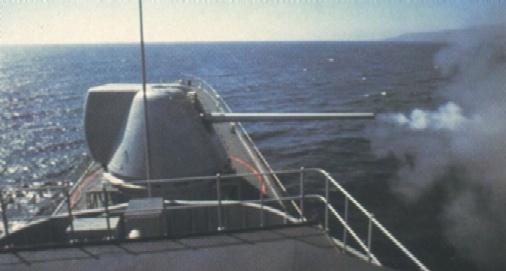
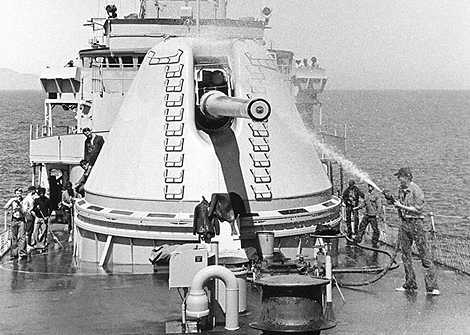

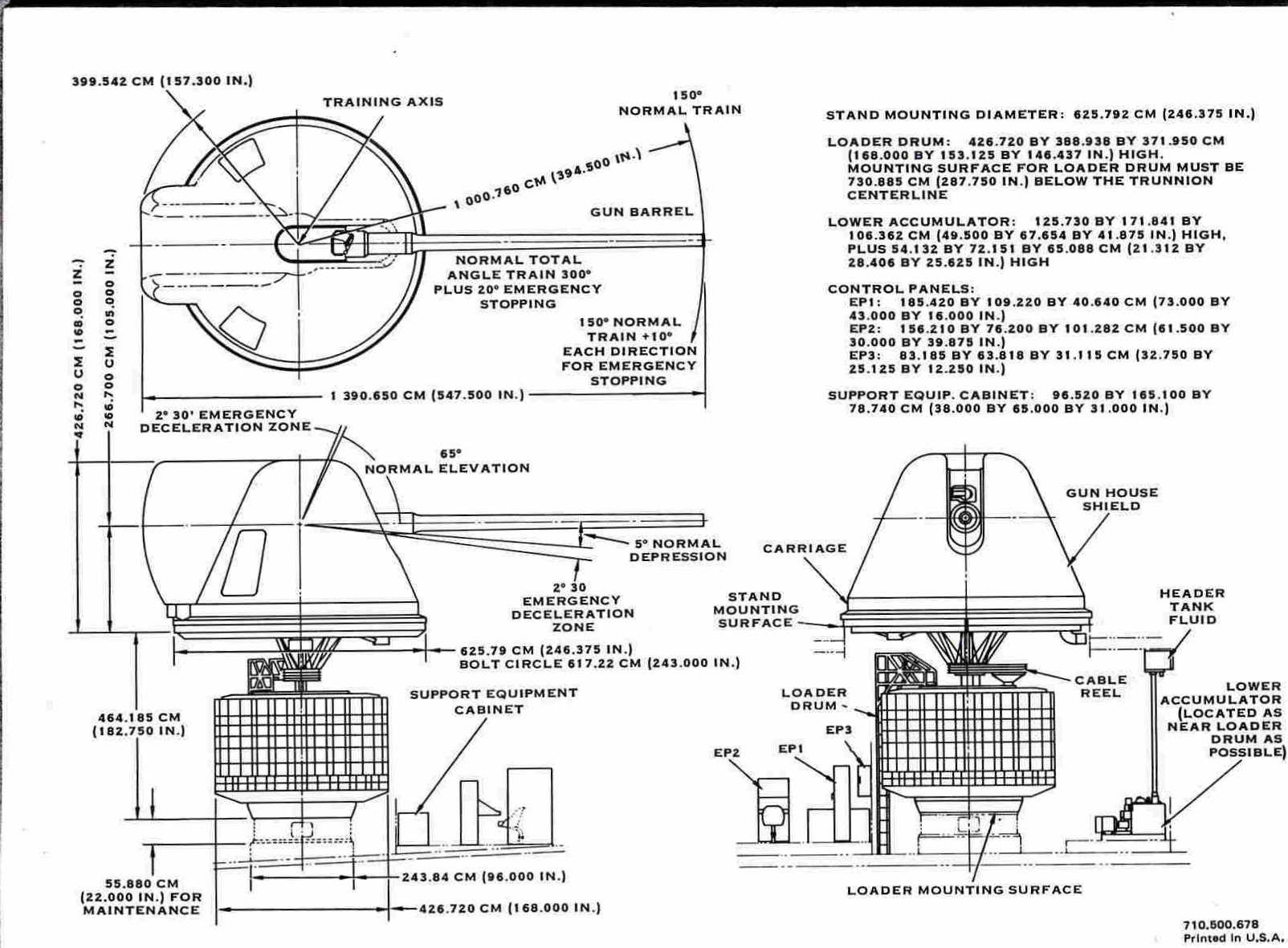

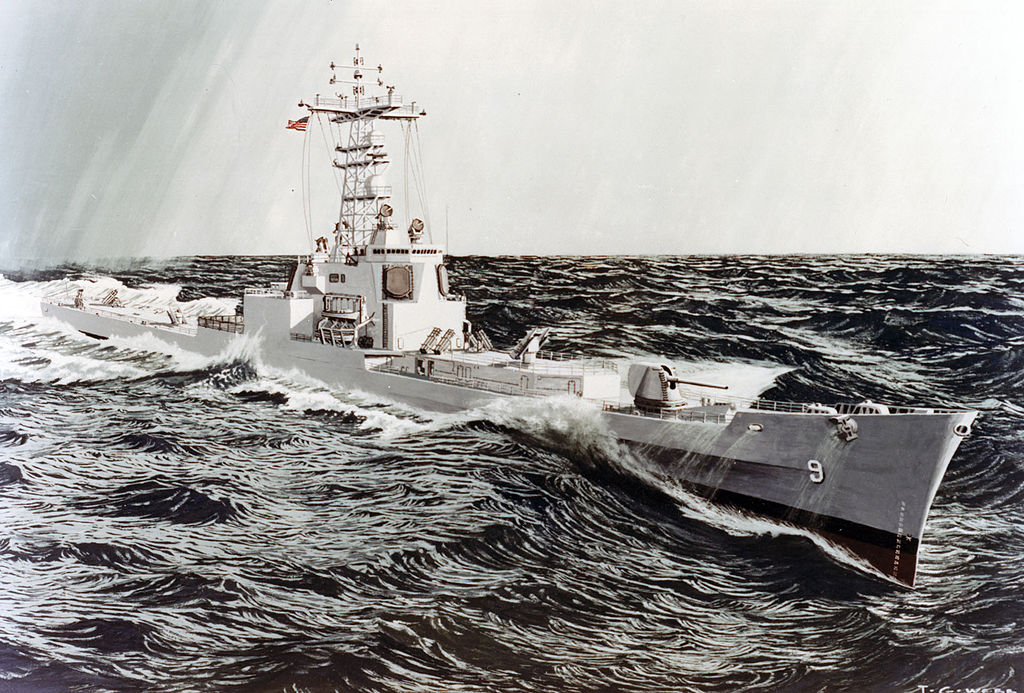

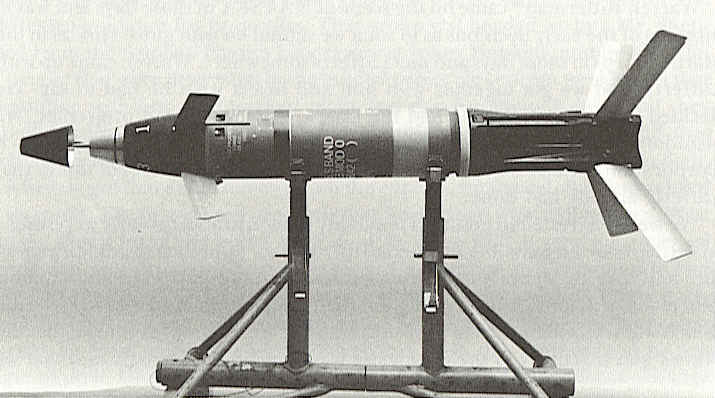
"US Naval Weapons" and "US Destroyers: An Illustrated Design History" both by Norman Friedman
"Dahlgren" by Kenneth G. McCollum, Editor
---
"Technical Evaluation of the 8-Inch Major Caliber Lightweight Gun Mount, Mark 71 Mod 0, Report NWL-TR-2854" by D.L. Bowen, Naval Proving Ground Dahlgren, Virginia
"Report: Flight Upgrade/041(4-RJS-1692) Final Report - DDG 51 Variant Study - Installation of Fixed Helicopter Hangar and 8-Inch Gun" by Gibbs & Cox, Inc., 23 September 1991
"Feasibility Study: Mk 71 8"/55 MCLWG Installation with Ammunition Lateral Transfer System on DD 963 Class" Prepared by Ordnance Design - Code 280, Puget Sound Naval Shipyard, 20 May 1977
---
Special help from Leo Fischer (Project Engineer on the Mark 71)
01 April 2008 - Benchmark
11 January 2011 - Added ammunition stowage details, comments about cracks on USS Hull, CLGP ramming sheath, note about DDG-51 variant
05 March 2011 - Added USS Hull test shoot data and installation sketch
27 July 2016 - Converted to HTML 5 format
07 August 2021 - Reorganized notes
23 February 2022 - Added images of Mark 71 mounting components and USS Long Beach (CGN-9) as a Strike Cruiser
12 November 2023 - Added FMC Advertising Pamphlet
23 September 2024 - Fixed manufacturer name

